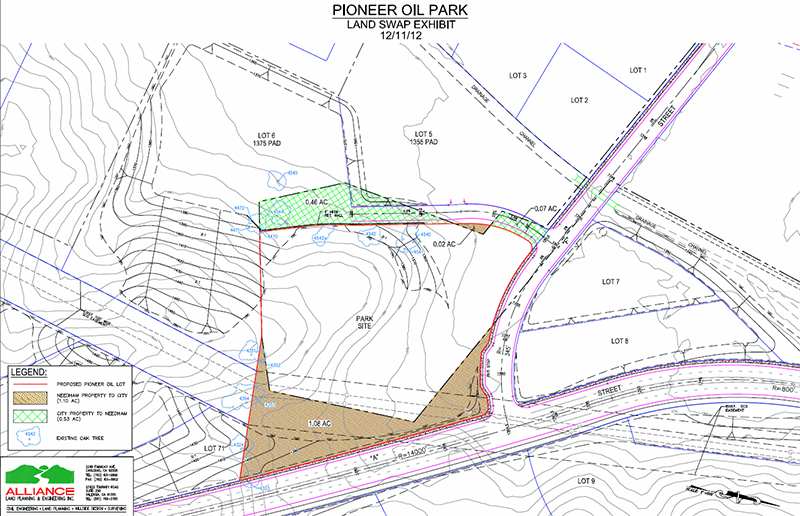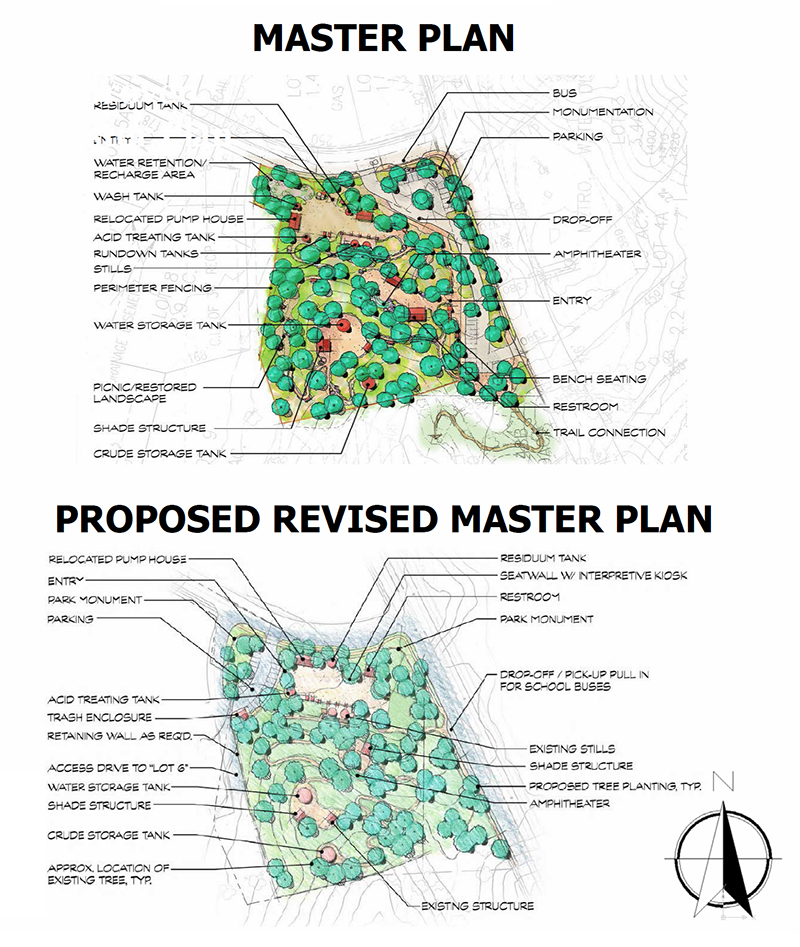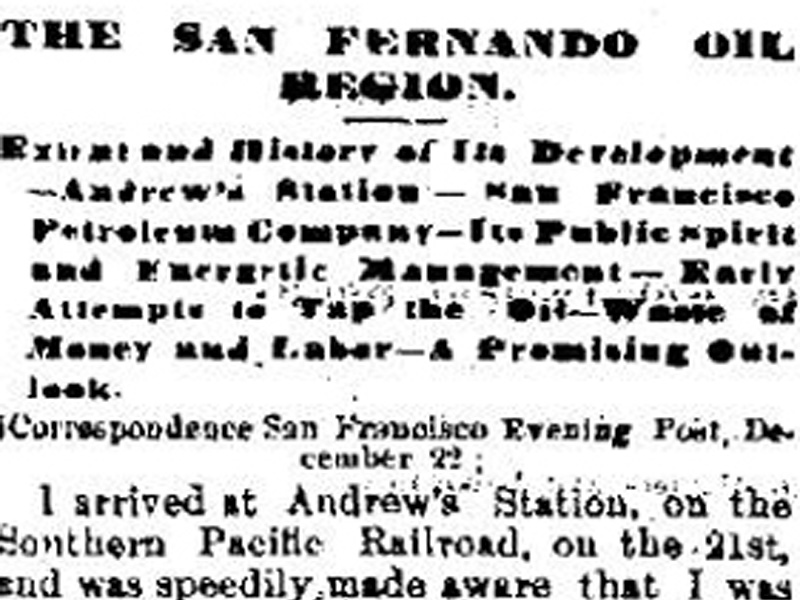SUBJECT: APPROVAL OF PIONEER OIL REFINERY REVISED MASTER PLAN
CITY OF SANTA CLARITA AGENDA REPORT
CONSENT CALENDAR (Item 7)
DATE: June 11, 2013
Item to be presented by: Rick Gould
DEPARTMENT: Parks, Recreation, and Community Services
RECOMMENDED ACTION
City Council approve the Revised Master Plan for the Pioneer Oil Refinery.
BACKGROUND
The City owns approximately 4.5 acres of land of a partially developed historic site, the former Pioneer Oil Refinery. The property is located south of Pine Street, surrounded on three sides by the proposed Gates-King Development (developer). A 110 foot-wide easement to Southern California Gas Company (Gas Company) is located along the property's eastern boundary.
In July of 2011, the City Council approved the Master Plan for the Pioneer Oil Refinery (Refinery). The Master Plan was developed through a process that included participation from staff and the public at several meetings and workshops in 2010 and 2011. The original Master Plan was facilitated by RJM Design Group.
In performing due diligence work as part of the development process, the developer learned that parking lot and bus turnout improvements proposed by the Master Plan for the Refinery on the Gas Company easement are not allowed.
The developer is proposing a boundary adjustment that will deed Lot 18A, containing the Gas Company easement and a portion of another lot contiguous to the City's property, for inclusion into the Refinery property. This would be in exchange for a piece of the Refinery property on the west edge of the site. This land swap would allow the developer improved access to an existing lot and result in an increase to the Refinery property of approximately three-quarters of an acre. Although much of Lot 18A is encumbered by the Gas Company easement, it could serve as a landscaped buffer and backdrop to the Refinery.
At staff's recommendation, the developer hired RJM Design Group, the park planning firm that prepared the original Master Plan for the Pioneer Oil Refinery. A revision to the Master Plan has been proposed to accommodate the changes. Major elements of the proposed revised Master Plan include relocation of the existing pump house ruins located on the northwest corner of the property, relocation of the parking area to the northwest corner of the property, revised pedestrian paths, and a bus turnout/drop-off area off of "A" Street. In addition to the improved buffer from "A" Street, the proposed changes to the Master Plan shift the parking and entrance to the northwest corner of the site, closer to Pine Street and nearby Heritage Junction.
Members of the public, area businesses, and the Santa Clarita Valley Historical Society had the opportunity to review the proposed revisions to the Master Plan in both a focus group setting and at the April 4, 2013 meeting of the Parks, Recreation and Community Services Commission. Staff received no objections to the proposed revision at either meeting. The Parks, Recreation, and Community Services Commission unanimously supported the revised Master Plan.
ALTERNATIVE ACTIONS
Other action as approved by City Council.
FISCAL IMPACT
No fiscal impact as a result of this action.
ATTACHMENTS
Comparison of Current and Proposed Master Plan [see above]
Pioneer Oil Refinery Proposed Land Swap [see below]
Roll call vote on consent calendar:
Ayes: McLean, Weste, Boydston, Kellar
Noes: None
Absent: Ferry
Motion carried.
 CLICK MAP TO ENLARGE
CLICK MAP TO ENLARGE
About the Pioneer Oil Refinery
About the Pioneer Oil Refinery.
The Pioneer Oil Refinery on Pine Street in Newhall dates to 1877, when oil driller Alex Mentry was breaking new ground in Pico Canyon and Chinese track layers had just finished hammering rails through Henry Newhall's recently purchased rancho. The little 15-barrel still that had been erected in 1874 at Lyon's Station (now Eternal Valley Cemetery) just wasn't working out. It couldn't produce a smoke-free kerosene — oil's major use in those days — and in 1875 it was shut. Besides, it was almost a mile away from the coming railroad.
Andrew Kraszynski's brand-new stagecoach stop at the mouth of Railroad Canyon made the ideal location for a new refinery. Not only did it have a bountiful supply of water for refining operations, but it sat right next to the train tracks.
John A. Scott, an experienced refiner from Pennsylvania, supervised construction. Scott moved the little 15-barrel still and another 20-barrel still from Lyon's to Andrew's and added a large, 120-barrel cheesebox still. Completed in August 1877, the refinery was an instant success.
Meanwhile, up at Pico, Alex Mentry had resumed his well-deepening campaign, which had stalled out after a water shortage. Mentry laid a pipe from a water source in a neighboring canyon for his steam drilling machinery. Within two months he was producing more oil than the Pioneer refinery could handle, so a fourth and even larger 150-barrel cheesebox still was added.
Oil itself was used in the distillation process. Heavy residual oil from earlier refining runs fueled the brick ovens beneath the stills. Tall brick chimneys vented what must have been massive amounts of smoke. Petroleum gasses passed into a condenser consisting of a wooden box with 1,400 feet of layered iron pipe submerged in water. The condensed oils flowed into a lead-lined agitator, where they were treated with chemicals and mixed with air to improve their burning quality.
The Pioneer Oil Refinery at Andrew's Station added benzene and illuminating oil for ships, railroads, factories and mines to California Star Oil's list of products. The breadwinner, though, was clean-burning kerosene in two grades.
Within a few years, oil was flowing all along the California coast. A huge refinery was set up at Alameda, directly across the bay from San Francisco — a much more practical location than the little burgh of Newhall. In 1888, the refining operation at Andrew's Station ceased for all time.
For about a dozen years, the Pioneer Oil Refinery off of Pine Street served to light up the western frontier. It was the first commercially successful oil refinery in the Western United States and is believed to be the oldest existing refinery in the world. Today its idle smokestacks and empty stills cast long shadows on the dawning of California's oil industry — an industry whose roots are intertwined with those of the Santa Clarita Valley.
The Pioneer Oil Refinery in Newhall is State Historical Landmark No. 172.
— Leon Worden 1997
Notes: The city of Santa Clarita acquired the Pioneer Oil Refinery property as a gift from Chevron USA in 1997 (escrow closed in April 1998) with the intent of restoring it and turning it into a public park. Funding was/is to come in part from developer fees associated with the Gate-King ("Needham Ranch") Industrial Park, which would surround it. (The refinery would find itself at the intersection of two roads leading into the business park.) The Santa Clarita City Council approved the buiness park in 2003, but then
the development was tied up in court with environmental lawsuits. Construction of the first of three phases of the business park finally commenced in late 2017, fourteen years after approval.
In early 2021, while grading for Phase II of the Needham Ranch business park was underway, the City of Santa Clarita began physical work on the restoration of the refinery, beginning with temporary removal
of the refinery features in order to stabilize and compact the soil and pour new foundations.
























